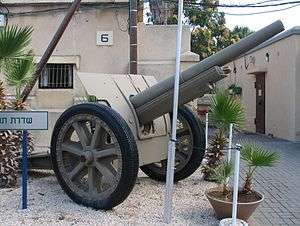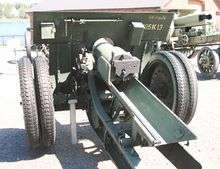Canon de 105 mle 1913 Schneider
The Canon de 105 mle 1913 Schneider was a French artillery piece used in World War I and World War II by many European countries.
| Canon de 105 mle 1913 | |
|---|---|
 Canon de 105 mle 1913 with rubber tires, in Batey ha-Osef Museum, Tel Aviv, Israel. | |
| Type | Field gun |
| Place of origin | France |
| Production history | |
| Designer | Schneider |
| Manufacturer | Schneider |
| No. built | ~1,600 carriages ~2,000 barrels[1] |
| Specifications | |
| Mass | Combat: 2,300 kg (5,071 lb) Travel: 2,650 kg (5,843 lb) |
| Barrel length | 2.987 m (9 ft 10 in) L/28.4[2] |
| Shell | 105 x 390mm R |
| Shell weight | 15.7 kg (35 lb)[3] |
| Caliber | 105 mm (4.134 in) |
| Breech | interrupted screw |
| Carriage | fixed trail |
| Elevation | -5° to 37° |
| Traverse | 6° |
| Muzzle velocity | 550 m/s (1,805 ft/s) |
| Maximum firing range | 12 km (7.45 mi) |
History
In the early 1900s, the French company Schneider began a collaboration with the Russian company Putilov. For this collaboration, it had developed a gun using the Russian 107 mm round, which was ordered by the Russian Army to be produced in Russia (though the initial batch of guns was made in France). Schneider then decided to modify the design for the French 105 mm (4.134 inches) round and offer it to France as well. Initially, the French army was not interested in this weapon as they already had plenty of 75 mm field guns. However, in 1913, the French army purchased a small number under the designation Canon de 105 mle 1913 Schneider; it was also known by the service designation L 13 S.[4]
The lighter 75 mm guns were of limited use against trenches; so, once the western front in World War I had settled down to trench warfare, the French army ordered large numbers of the L 13 S, which, with its larger 15.74 kg (34.7 lb) shell, was more effective against fortified positions and had a range of 12,000 metres (7.5 mi).
After the end of World War I, France sold or gave many Schneider 105 mm guns to various other countries, including Belgium, Italy, Poland, and Yugoslavia. In Italy, the 105 mm was re-designated the Cannone da 105/28 and saw service until 1943.[4] Guns were also produced under license in Italy, starting from September 1914, by Ansaldo.[5] Poland also used new model of Schneider's gun with a longer barrel and split trail, called the wz. 29, which was in fact a completely different weapon; both were in service at the beginning of WW II in 1939. In 1939 Poland had 118 of wz. 13 guns and 124 of wz. 29 guns, used in Heavy Artillery Detachments.[6]
The German conquests of Poland, Belgium, France, and Yugoslavia during World War II gave them large numbers of captured 105 mm Schneider guns. 854 L 13 S's were in service in France and a large number were captured. Many of these were installed in the Atlantic Wall system of coastal defenses.[4]
Finland was able to buy 12 of these guns from France during the Winter War; they also rebarreled six Russian 107mm Schnieders (four 1910 and two 1913 models) to 105mm. In addition, they were able to purchase 54 captured Polish Armata 105 mm wz. 29 Schneider guns from Germany.[7]
During WW1, Russian army abandoned 36 pieces in Romania which were put into service in two artillery independent battalions.
Designations


Because the gun was used by many countries, it had many official designations.[4]
- Canon de 105 mle 1913 Schneider - French designation
- 105 L - designation by French army during World War I
- The Italian designation was Cannone da 105/28 modello 1913, often shortened to Cannone da 105/28
- 105 mm armata wz. 13 and 105 mm armata dalekonośna wz. 29 were Polish designations for the original gun and a modernised version respectively
- German designations include:
- 10.5 cm K 331(f) for guns captured from France
- 10.5 cm K 333(b) for guns captured from Belgium
- 10.5 cm K 338(i) for guns captured from Italy
- 10.5 cm K 338(j) for guns captured from Yugoslavia
- 10.5 cm K 13(p) and 10.5 cm K 29(p) for guns captured from Poland
- 105 K/13, 105 K/10 and 105 K/29 were the Finnish designations for the guns. 105 K/13 was the original French Gun, 105 K/10 was the 107mm Russian Gun rebarrelled to 105mm, while 105 K/29 were Polish 105 mm wz. 29 Schneider guns (These were captured guns which had been sold to Finland by Germany).[7]
References
- Guy François, "Le 105 L modèle 1913, l'élégant du Creusot", Histoire de Guerre, Bildés & Materiél, no. 103, January 2013, pp. 27-37, Paris: Histoire & Collection (in French) toc Archived 2014-08-06 at the Wayback Machine
- Chamberlain, Peter (1975). Light and medium field artillery. Gander, Terry. New York: Arco. p. 16. ISBN 0668038209. OCLC 2067331.
- "101". www.quarryhs.co.uk. Retrieved 2017-09-03.
- Chris Bishop (2002). The Encyclopedia of Weapons of World War II. Sterling Publishing Company. p. 138. ISBN 978-1-58663-762-0.
- 105mm_mle1913- Retrieved 2012-03-01
- Konstankiewicz, Andrzej (2003). Broń strzelecka i sprzęt artyleryjski formacji polskich i Wojska Polskiego w latach 1914-1939, Lublin. pp. 250-266. ISBN 83-227-1944-2. (in Polish)
- "ARTILLERY PART 4: Heavy Field Guns (105 mm - 155 mm)". jaegerplatoon.net. Archived from the original on 2011-01-27. Retrieved 2014-04-17.
- Artillery by Chris Chant, ISBN 1-84509-248-1, pages 31, 50-51.
External links
| Wikimedia Commons has media related to Canon de 105 modèle 1913 Schneider. |